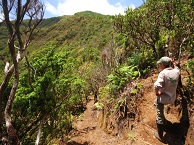

Along the LIFE Priolo and LIFE Sustainable Laurel Forest projects, several Laurel Forest areas were restored with the objective of eradicating invasive alien species and improve quality of habitat through the plantation of native species. These areas require continuous intervention so that invasive alien species (IAS) pressure can be avoided. The actions developed within the LIFE projects allowed the creation of a significant area of Laurel Forest free from IAS (around 275 ha).
Chronologically, the intervention areas are:
* Viewpoint of Tronqueira (2004 - 2006): The area of forest visible from the viewpoint of Serra da Tronqueira encloses the largest native forest in São Miguel. In previous decades, this area had been progressively taken over by invasive species, such as the Yellow Ginger-Lilly (Hedychium gardneranum) and the Lilly-of-the-valley Tree (Clethra arborea). The LIFE-Priolo project allowed the recovery of this area by removing all IAS and planting native species in 2004. Nowadays, the effects of the intervention are no longer visible and the area presents a fully natural landscape.
* Garden of Endemic Plants of the Recreational Forest reserve of Cancela do Cinzeiro, Nordeste (2005): In the Recreational Forest Reserve of Cancela do Cinzeiro (managed by the Nordeste Forestry Service), one can find a Garden of Endemic Plants and a circular walking trail. Visitors can easily see the diversity of species of the Azorean Laurel Forest, such as the Azorean Holly (Ilex perado ssp. azorica), Azorean Juniper (Juniperus brevifolia), Azorean Laurel (Laurus azorica), Cape Myrtle (Myrsine retusa), Azorean Cherry (Prunus azorica), Azorean Blueberry (Vaccinium cylindraceum) and Azorean Smaller Hawkbit (Leontodon sp.).
* Central Area of Pico da Vara Nature Reserve (2005 - 2008): The biggest continuous intervention area (more than 200 hectares) in all the LIFE projects and also the most important for the Azores Bullfinch conservation. This area was in better initial conservation conditions than other areas and, thus recovering faster and almost without the necessity of planting native species. Nowadays, the effects of the intervention are no longer visible, except if compared with close invaded areas.
* Pico Bartolomeu (2009): This area houses altitudinal Laurel Forest and presented high invasion rates by the Lilly-of-the-valley Tree (Clethra arborea). It is accessible through the Forestry Reserve of Cancela do Cinzeiro, where Priolo’s Environmental Center is located.
* Labaçal (2010 - 2011): The area of Labaçal – Pico da Vereda is close to Tronqueira road in the council of Povoação. Before the intervention this low area presented a high invasion rates by the Australian Cheesewood (Pittosporum undulatum). Here, some of the impacts of the intervention are still visible, such as the presence of clearings in the forest with young vegetation. It is expected that the Laurel Forest will recover completely in this area within a few years, such as it happened in the Viewpoint of Tronqueira, especially in the clearings which were once areas highly infested by Cheesewood.
* Malhada (2010 - 2013): High altitude Laurel Forest area that presented high invasion rates by the Lilly-of-the-valley Tree (Clethra arborea) and Ginger-Lilly (Hedychium gardnerarum). This area is adjacent to the pedestrian trail from Lomba da Fazenda to Pico da Vara.
* Mata dos Bispos (2012): Low altitude area, in the council of Povoação with high invasion rates by Australian Cheesewood (Pittosporum undulatum). It is the latest intervention area and the effects of the intervention are still clearly visible.
< Previous page